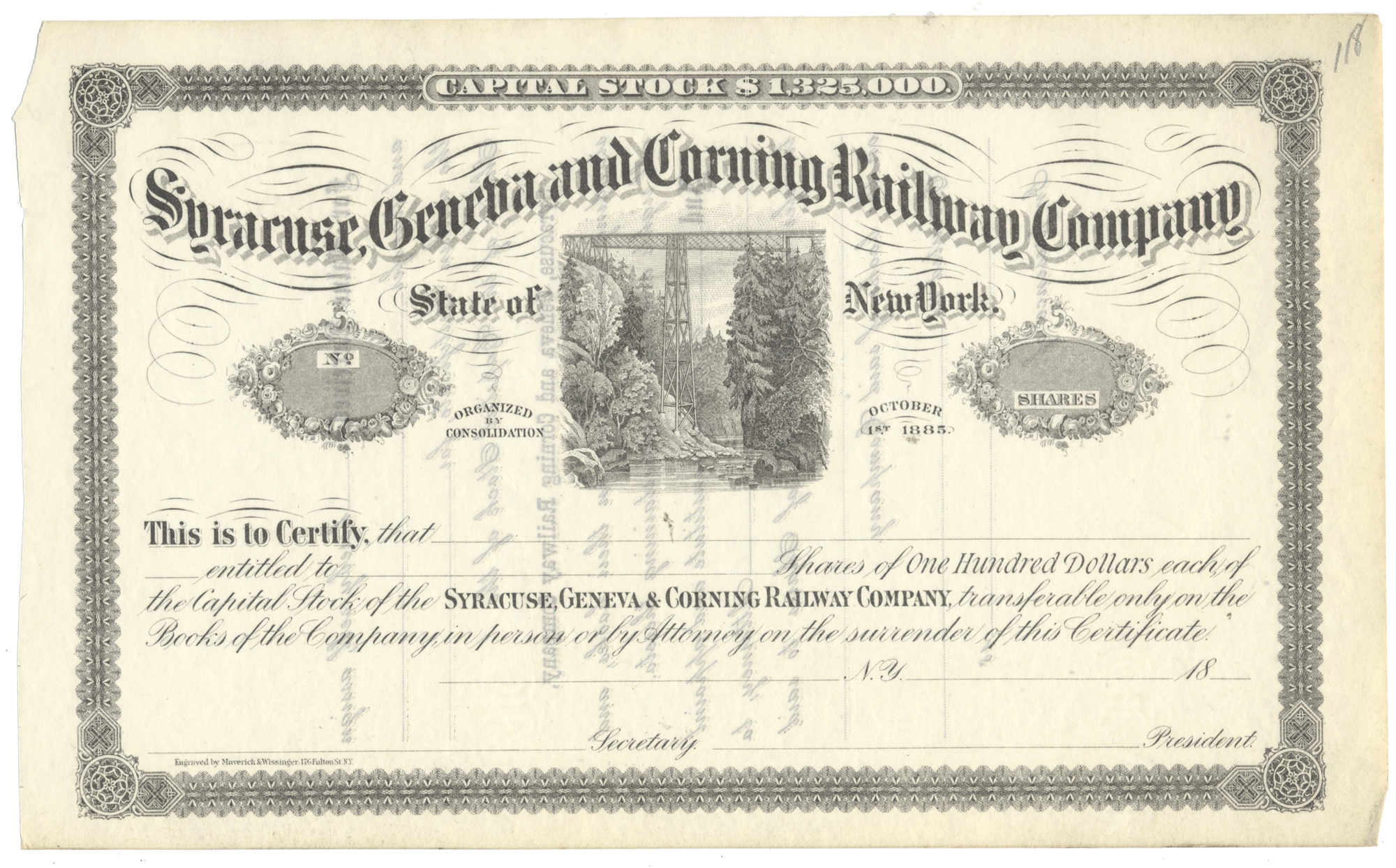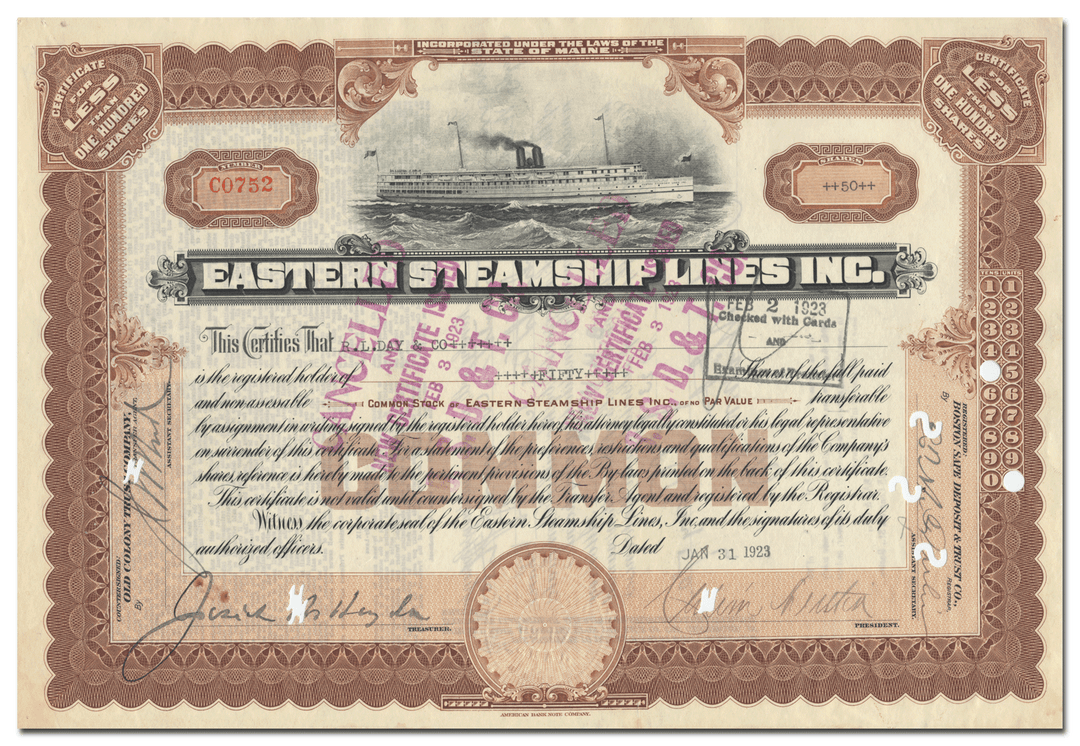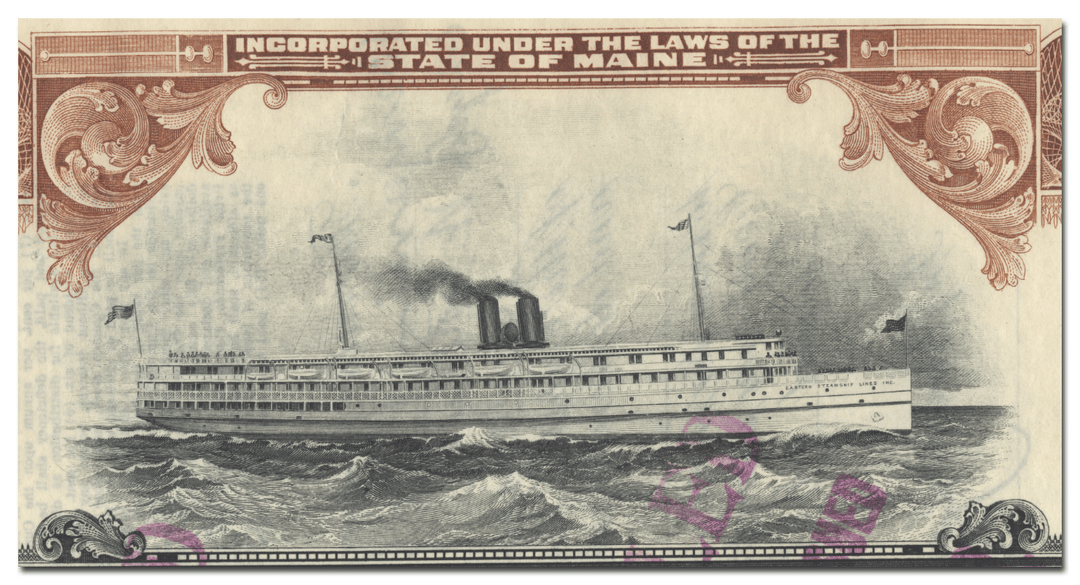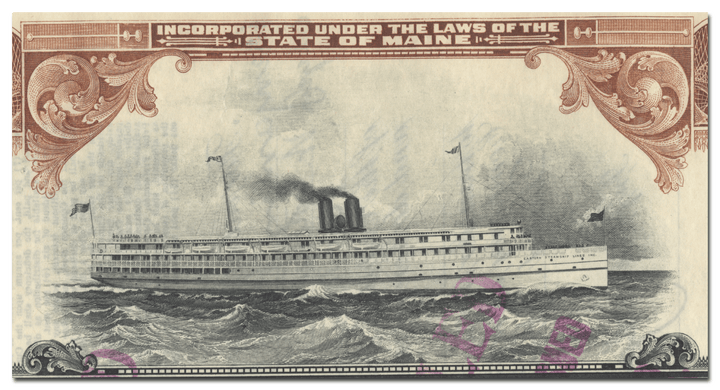Eastern Steamship Lines, Inc.
- Guaranteed authentic document
- Orders over $75 ship FREE to U. S. addresses
Product Details
CompanyEastern Steamship Lines, Inc.
Certificate Type
Common Stock
Date Issued
January 31, 1923
Canceled
Yes
Printer
American Bank Note Company
Signatures
Hand signed
Approximate Size
11 3/4" (w) by 8" (h)
Images
Show the exact certificate you will receive
Guaranteed Authentic
Yes
Additional Details
NA
Historical Context
Eastern Steamship Lines was a shipping concern created through successive mergers by Wall Street financier and speculator Charles Wyman Morse. It built numerous ships for the United States government in World War I, and served as operator of a large number of vessels on behalf of the War Shipping Administration in World War II.
In 1911 Morse consolidated the Metropolitan Steamship Company and Maine Steamship Company with the Eastern Steamship Company to form Eastern Steamship Corporation. It went into receivership in 1914 and emerged in 1917 as Eastern Steamship Lines.
Early Roots
Morse was already involved in the shipping business while a student at Bowdoin College, and at his graduation in 1877 he had accumulated a sizable capital. After college he went into business with his father and a cousin, Harry F. Morse, forming C.W. Morse & Company and engaging in an extensive business shipping ice and lumber.
After profiting in the creation and sale of substantial holdings known as the "Ice Trust," Morse returned to the realm of shipping in 1901, when he established the Eastern Steamship Company by consolidating the Boston and Bangor Steamship Company, dating from 1834; the Portland Steam Packet Company, organized in 1843; and the International Steamship Company, established in 1859.
In 1902 Morse acquired control of both overnight steamboat lines on the Hudson River - the People's Line, established in 1835, and the Citizens' Line, established in 1872 - and organized the Hudson Navigation Company to operate them. They were collectively known as the Hudson River Night Line. The People's Line named its new 411-foot steamer C.W. Morse in his honor in 1904. (Morse's uncle James Thomas Morse, his father's brother, was the namesake of the Rockland-Bar Harbor, Maine, steamer J.T. Morse, also built in 1904.)
Metropolitan Steamship Company
Morse acquired control of the Metropolitan Steamship Company from the Whitney interests in 1906. He organized the Consolidated Steamship Company in January 1907 as a holding company for the Eastern Steamship Company, Metropolitan Steamship Company Clyde Steamship Company and Mallory Steamship Company. Despite an initial announcement of such a sale, Morse failed in an attempt to purchase the Long Island Sound steamers of the New York, New Haven and Hartford Railroad. He did, however, acquire control of the New York and Cuba Mail Steamship Company and the New York and Porto Rico Steamship Company in 1907.
He parlayed this success into a prominent role in high finance in New York City. A failure speculating in 1907 led to the collapse of banking interests Morse had acquired driving his steamship lines into receivership, for varying periods, in February 1908.
Indicted by United States District Attorney Henry L. Stimson, Morse was convicted of violations of federal banking laws. He was sentenced to 15 years in the Atlanta federal penitentiary in November 1908 but remained free on appeal.
Formation
On October 8, 1909, the assets of the Metropolitan Steamship Company were sold at foreclosure sale to John W. McKinnon of Chicago. The company was reincorporated three days later in Maine with Morse as president. The Metropolitan Steamship Company and Maine Steamship Company were consolidated with the Eastern Steamship Company in 1911 to form Eastern Steamship Corporation. This concern went into receivership in 1914 and emerged in 1917 as Eastern Steamship Lines.
After a period in prison Morse returned to the shipping business. He still controlled the Hudson Navigation Company, which had not been involved in the crash of the Consolidated Steamship Company in 1907. Morse announced on January 11, 1916, plans for a new transoceanic steamship line, which he organized as the United States Shipping Company. This holding company exchanged its stock for that of 16 subsidiary companies, each organized around a steamship.
World War I
During World War I he was president of United States Steamship Company, which was the parent company of Groton Iron Works and Virginia Shipbuilding Corporation. The Virginia Shipbuilding Company won contracts to build 36 vessels for the war effort. The freighters were ordered by the United States Shipping Board, and Morse borrowed from the Emergency Fleet Corporation funds to carry out the contracts. Ultimately, 22 of the ships were completed; the other 14 were canceled.
Morse controlled the Hudson Navigation Company until its bankruptcy in 1921. The receivers quickly changed the name of the C.W. Morse to Fort Orange.
World War II
Eastern Steamship Lines served as operator for the War Shipping Administration in World War II, especially Victory ships.
Post World War II
After World War II, cruise ships became popular. At first it operated only the Boston-Yarmouth line. Liners instead sailed out of Miami and in 1954, the line was unprofitable so the Nova Scotia government intervened with subsidizing Yarmouth and Evangeline until the 1954 season. The company was bought out by Gotass Larsen in 1970. The company was renamed Eastern Cruises in 1981 and amalgamated with Western Cruise Lines and Sundance Cruises to form Admiral Cruises.
Related Collections
Additional Information
Certificates carry no value on any of today's financial indexes and no transfer of ownership is implied. All items offered are collectible in nature only. So, you can frame them, but you can't cash them in!
All of our pieces are original - we do not sell reproductions. If you ever find out that one of our pieces is not authentic, you may return it for a full refund of the purchase price and any associated shipping charges.









